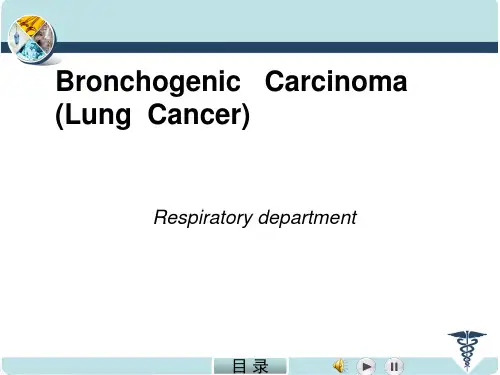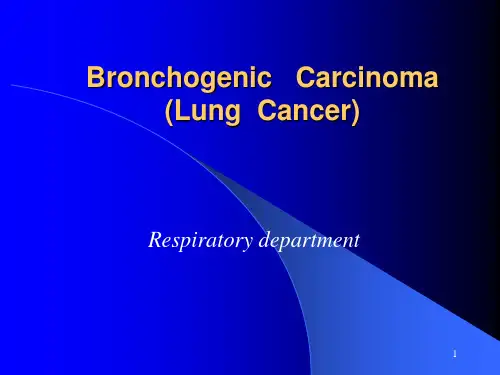优选讲课肺癌英文
- 格式:ppt
- 大小:7.05 MB
- 文档页数:62
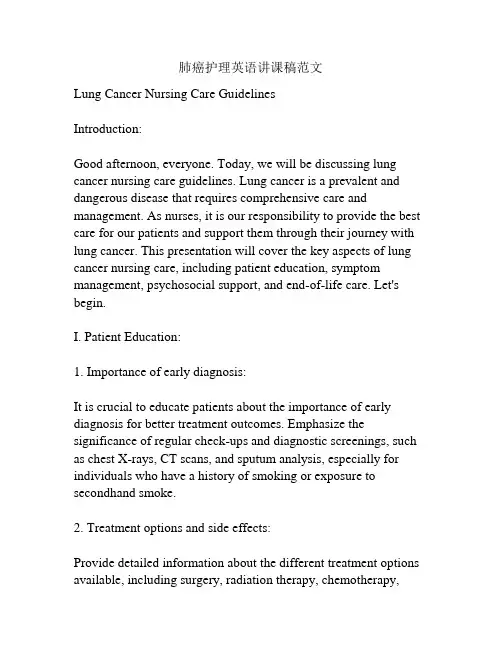
肺癌护理英语讲课稿范文Lung Cancer Nursing Care GuidelinesIntroduction:Good afternoon, everyone. Today, we will be discussing lung cancer nursing care guidelines. Lung cancer is a prevalent and dangerous disease that requires comprehensive care and management. As nurses, it is our responsibility to provide the best care for our patients and support them through their journey with lung cancer. This presentation will cover the key aspects of lung cancer nursing care, including patient education, symptom management, psychosocial support, and end-of-life care. Let's begin.I. Patient Education:1. Importance of early diagnosis:It is crucial to educate patients about the importance of early diagnosis for better treatment outcomes. Emphasize the significance of regular check-ups and diagnostic screenings, such as chest X-rays, CT scans, and sputum analysis, especially for individuals who have a history of smoking or exposure to secondhand smoke.2. Treatment options and side effects:Provide detailed information about the different treatment options available, including surgery, radiation therapy, chemotherapy,targeted therapies, and immunotherapy. Discuss the potential side effects associated with each treatment and explain how they can be managed.3. Smoking cessation:Strongly advocate for smoking cessation to all patients, regardless of whether they are current or former smokers. Explain the benefits of quitting smoking, such as improving treatment responses and overall survival rates. Offer resources and support, such as smoking cessation programs or nicotine replacement therapies.II. Symptom Management:1. Pain management:Lung cancer can cause various types of pain, including chest pain, bone pain, or neuropathic pain. Collaborate with the multidisciplinary team to develop an individualized pain management plan. Administer analgesics according to the World Health Organization (WHO) analgesic ladder and monitor the patient's pain levels regularly.2. Dyspnea management:Dyspnea, or difficulty breathing, is a common symptom in lung cancer patients. Teach breathing techniques, such as pursed-lip breathing and diaphragmatic breathing, to help alleviate dyspnea. Encourage physical activity and exercise programs tailored to the patient's abilities to improve lung function and reducebreathlessness.3. Nausea and vomiting:Chemotherapy and radiation therapy can cause nausea and vomiting in lung cancer patients. Administer antiemetics as prescribed and encourage patients to eat small, frequent meals that are easily digestible. Provide information about recommended dietary modifications to minimize nausea and vomiting, such as avoiding fatty or spicy foods.4. Fatigue management:Cancer-related fatigue is a significant issue for lung cancer patients. Educate patients on energy-saving strategies, such as pacing activities, prioritizing rest, and delegating tasks to conserve energy. Teach relaxation techniques, such as deep breathing exercises and guided imagery, to help manage fatigue.III. Psychosocial Support:1. Emotional support:Lung cancer diagnosis can induce a range of emotions, including anxiety, fear, and sadness. Create a safe and supportive environment for patients to express their feelings and concerns. Offer counseling services or refer patients to support groups where they can connect with others facing similar challenges.2. Caregiver support:Recognize the role of caregivers in supporting lung cancer patients and provide them with information and resources. Educate caregivers about the disease progression, treatment plans, and potential side effects to help them better assist the patient. Offer respite care options to allow caregivers time for self-care and relaxation.3. Palliative care and hospice:Discuss palliative care and hospice options with patients and their families, ensuring they understand the benefits and limitations of these services. Collaborate with the palliative care team to enhance pain and symptom management and provide emotional support during end-of-life care.IV. End-of-Life Care:1. Advance care planning:Initiate end-of-life discussions early to ensure patients' wishes regarding resuscitation status, medical interventions, and funeral arrangements are documented. Encourage patients to designate a healthcare proxy and complete advance directives, such as living wills or Do Not Resuscitate (DNR) orders.2. Comfort measures:Focus on providing comfort and alleviating distressing symptoms during the end-of-life stage. Monitor and manage pain, dyspnea,anxiety, and other distressing symptoms using pharmacological and non-pharmacological interventions. Collaborate with the palliative care team and involve other healthcare professionals, such as spiritual counselors or psychologists, as needed.3. Bereavement support:Offer bereavement support to the family members after the patient's death. Provide information about grief support groups or counseling services to help them navigate their bereavement process. Follow-up with the family periodically to assess their coping strategies and provide ongoing support if necessary.Conclusion:In conclusion, effective lung cancer nursing care requires a holistic approach that encompasses patient education, symptom management, psychosocial support, and end-of-life care. By implementing these guidelines, we can enhance the care we provide to lung cancer patients and support them throughout their cancer journey. Thank you for your attention, and I hope this presentation has been informative and helpful to you in your nursing practice.。
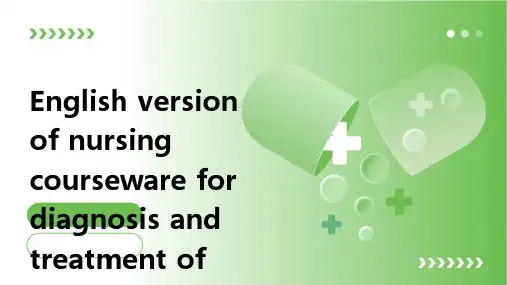

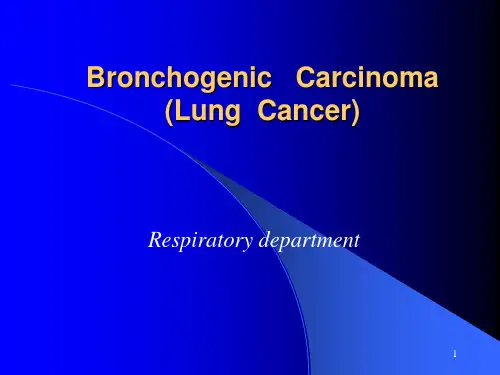
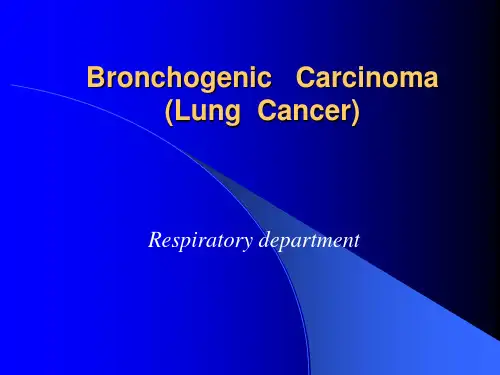

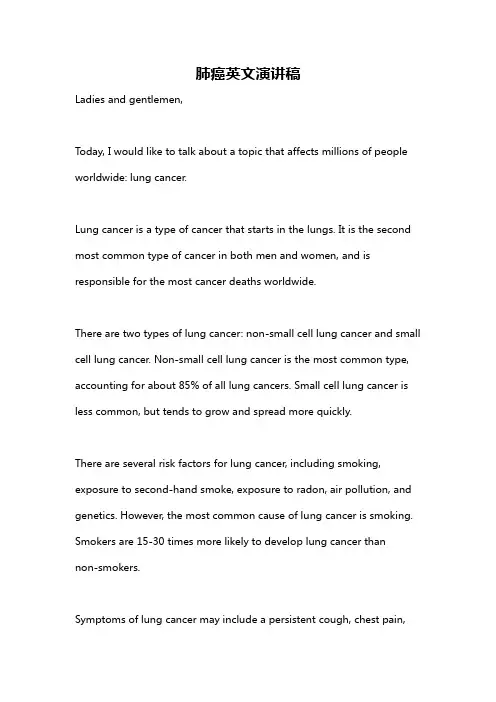
肺癌英文演讲稿Ladies and gentlemen,Today, I would like to talk about a topic that affects millions of people worldwide: lung cancer.Lung cancer is a type of cancer that starts in the lungs. It is the second most common type of cancer in both men and women, and is responsible for the most cancer deaths worldwide.There are two types of lung cancer: non-small cell lung cancer and small cell lung cancer. Non-small cell lung cancer is the most common type, accounting for about 85% of all lung cancers. Small cell lung cancer is less common, but tends to grow and spread more quickly.There are several risk factors for lung cancer, including smoking, exposure to second-hand smoke, exposure to radon, air pollution, and genetics. However, the most common cause of lung cancer is smoking. Smokers are 15-30 times more likely to develop lung cancer thannon-smokers.Symptoms of lung cancer may include a persistent cough, chest pain,shortness of breath, coughing up blood, fatigue, and weight loss. It is important to see a doctor if you are experiencing any of these symptoms.Unfortunately, lung cancer is often diagnosed at a late stage, when treatment may not be as effective. That is why it is important to be aware of the risk factors and symptoms, and to get regular check-ups.Treatment for lung cancer may include surgery, chemotherapy, radiation therapy, targeted therapy, or a combination of these methods. The best treatment plan will depend on the stage of the cancer, the person's overall health, and other factors.In conclusion, lung cancer is a serious and deadly disease that affects millions of people every year. By understanding the risk factors and symptoms, and by seeking early diagnosis and treatment, we can help to prevent and treat lung cancer. Thank you.。
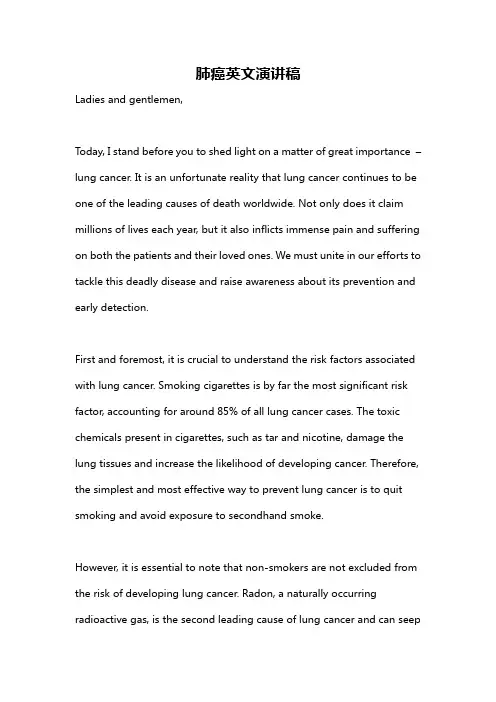
肺癌英文演讲稿Ladies and gentlemen,Today, I stand before you to shed light on a matter of great importance –lung cancer. It is an unfortunate reality that lung cancer continues to be one of the leading causes of death worldwide. Not only does it claim millions of lives each year, but it also inflicts immense pain and suffering on both the patients and their loved ones. We must unite in our efforts to tackle this deadly disease and raise awareness about its prevention and early detection.First and foremost, it is crucial to understand the risk factors associated with lung cancer. Smoking cigarettes is by far the most significant risk factor, accounting for around 85% of all lung cancer cases. The toxic chemicals present in cigarettes, such as tar and nicotine, damage the lung tissues and increase the likelihood of developing cancer. Therefore, the simplest and most effective way to prevent lung cancer is to quit smoking and avoid exposure to secondhand smoke.However, it is essential to note that non-smokers are not excluded from the risk of developing lung cancer. Radon, a naturally occurring radioactive gas, is the second leading cause of lung cancer and can seepinto homes through cracks in the foundation. Consequently, it is crucial to conduct regular radon testing and take measures to reduce its presence if necessary.Furthermore, occupational exposure to carcinogens such as asbestos, arsenic, and certain chemicals can also increase the risk of lung cancer. Therefore, individuals working in industries where such exposure is possible should adhere to safety protocols and use protective gear to minimize the risk.Early detection is undoubtedly a game-changer when it comes to lung cancer. The survival rate for early-stage lung cancer is significantly higher than for advanced cases. Thus, it is essential for individuals at high risk, such as long-term smokers or those with a family history of lung cancer, to undergo regular screenings and diagnostic tests.Education plays a pivotal role in fostering a profound understanding of the importance of prevention and early detection. Schools, communities, and healthcare institutions must collaborate to raise awareness about the risks of smoking and encourage healthy lifestyle choices. Engaging in public campaigns, organizing seminars, and distributing informative pamphlets are just a few ways to disseminate crucial knowledge andpromote positive change.Lastly, we must support research and development efforts to find more effective treatments for lung cancer. Innovative therapies, such as immunotherapy, targeted therapy, and gene therapy, have shown promising results in extending the lives of lung cancer patients. Investing in scientific advancements and clinical trials can lead to breakthroughs that revolutionize the treatment landscape and offer hope to countless individuals battling this disease.In conclusion, lung cancer poses a significant threat to public health, causing immense harm and claiming countless lives each year. By focusing on prevention, early detection, education, and research, we can take significant strides towards reducing the burden of lung cancer. Let us stand together in the fight against this deadly disease and work toward a future where lung cancer is no longer a global health crisis.Thank you.。
